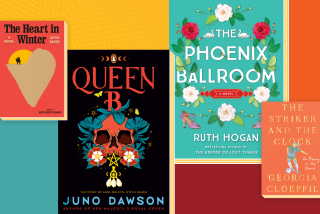T.C. Boyle holds nothing back in âStories IIâ
In the preface to âStories II,â which gathers all the short fiction he has published in the past 15 years, 58 stories, T.C. Boyle recalls a reading Stanley Elkin once gave at the Iowa Writers Workshop. âMr. Elkin,â a student asked, âyouâve written a terrific collection of stories â why donât you write more of them?â Elkinâs response? âNo money in it. Next question.â
The same has not been true of Boyle, who writes novels and short fiction interchangeably. And yet in these 900-plus pages â which include 14 stories that have never appeared in book form â Boyle means to give us more than a collection; rather, itâs an edifice intended, not unlike its equally massive predecessor âStoriesâ (1998), to define a legacy.
For Boyle thatâs a complex process, since his stories mix brilliance with high-concept pyrotechnics, meditations with whiz-bangery. Perhaps the best way to read âStories II,â then, is as an expression of Boyleâs aesthetic in all its complicated inconsistency.
As for the brilliant, thereâs âChicxulub,â perhaps the most moving story Boyle has written, previously published in the 2005 collection âTooth and Claw.â Here, a middle-aged father reflects on the asteroid that 65 million years ago struck the Yucatan and extinguished âat least seventy-five percent of all known species, including the dinosaurs,â framing it as a metaphor for the risks of parenthood, of family, and the disasters that can disrupt our own worlds with neither warning nor remorse. Itâs reminiscent of Jim Shepardâs âKrakatoa,â which also uses large events to reflect on the personal, but the fatalism is all Boyle.
âThe thing that disturbs me about Chicxulub,â he writes, â⌠is the deeper implication that we, and all our works and worries and attachments, are so utterly inconsequential. Death cancels our individuality, we know that, yes, but ontogeny recapitulates phylogeny and the kind goes on, human life and culture succeed us â that, in the absence of God, is what allows us to accept the death of the individual. But when you throw Chicxulub into the mix â or the next Chicxulub, the Chicxulub that could come howling down to obliterate all and everything even as your eyes skim the lines of this page â where does that leave us?â
Some version of this question recurs throughout âStories II,â a dark book in which bad things happen to good people, or people who think of themselves as good are revealed as anything but. In âKilling Babies,â a recovering drug addict snaps when confronted by protesters at his brotherâs abortion clinic; the narrator of âTermination Dust,â meanwhile, presents himself as reasonable, until in a moment of terrible reckoning, we discover that he is not.
Then thereâs the magnificent âSic Transit,â one of the new stories, in which a middle-aged businessman living in an affluent California community finds himself moved by the death of a reclusive neighbor, a former rock ânâ roller who was derailed by the drowning of his young daughter many years before. Why should we care about this, Boyle wonders. âThe answer is simple: he was you, he was me, he was any of us, and his life was important, all-important, the only life anybody ever lived, and when his eyes closed for the final time, the last half-eaten carton of noodles slipping from his hand, we all disappeared, all of us, and every creature alive too, and the earth and the light of the sun and all the grace of our collective being.â
To some extent, thatâs a sign of Boyle growing older; he will turn 65in December. Death, or the threat of death, is all over these stories â or more accurately, a sense of mortality, of time zeroing in. If his earlier work was marked by a gleeful willingness to take on anything, here his focus is largely naturalistic, even when, as in âDogologyâ or âThirteen Hundred Rats,â he pushes the boundaries of the believable.
The implication is that Boyle has little time for mere amusements. As the main character of âBalto,â a 13-year-old girl, observes of her father: â[F]or the first time she noticed the small gray dollop of loose flesh under his chin. It made him look old, worn out, past his prime, as if he werenât the hero anymore but playing the heroâs best friend, the one who never gets the girl and never gets the job.â
Thatâs a telling statement, revealing, as it does, a whisper of vulnerability. And yet, the deeper we get in âStories II,â the more we become aware of an odd temporal dislocation: not timelessness, exactly, but more a blurring of the line between old and young.
When Boyle is at his strongest, as in âThe Way You Look Tonight,â another new story in which a man in his late 20s discovers a sex tape his wife made in college posted on the Internet, this evokes a vivid empathy, of the necessity of acceptance.
âHe was remembering the first time heâd ever seen her,â he writes, â⌠and he didnât know a thing about her, didnât know her name or where she came from or that they liked the same books and bands and movies or that her whole being would open up to his and his to hers as if they had the same key and the key fit just exactly right.â
Too often though (âThe Night of the Satellite,â âBirnam Woodâ), his characters are more generic: twentysomething, drifter or grad student, marginally connected to the world. That was Boyle himself once â as per âUp Against the Wall,â about a young man who dabbles in heroin as he waits out the dreg ends of the 1960s â but itâs no longer who he is. And compared with Anent Riley, the bitter, aging writer in âThe Marlbane Manchester Musser Award,â or the Peeping Tom protagonist of âMy Pain is Worse Than Your Pain,â such figures fail to move us fully, or take on three-dimensional life.
This is one of the challenges of an omnibus: that by including everything, you donât weed out the lesser stuff. All the same, I have to give Boyle credit for holding nothing back.
In âStories IIâ we stare down 15 years of fiction, from the great to the serviceable, and how does it add up? âAll part of the questing impulse,â Boyle suggests, âthat has pushed me forward into territory I could never had dreamed of when I first set out to write â that is, to understand that there are no limits and everything that exists or existed or might exist in some other time or reality is fair game for exploration.â
Stories II
T.C. Boyle
Viking: 918 pp., $45
More to Read
Sign up for our Book Club newsletter
Get the latest news, events and more from the Los Angeles Times Book Club, and help us get L.A. reading and talking.
You may occasionally receive promotional content from the Los Angeles Times.








